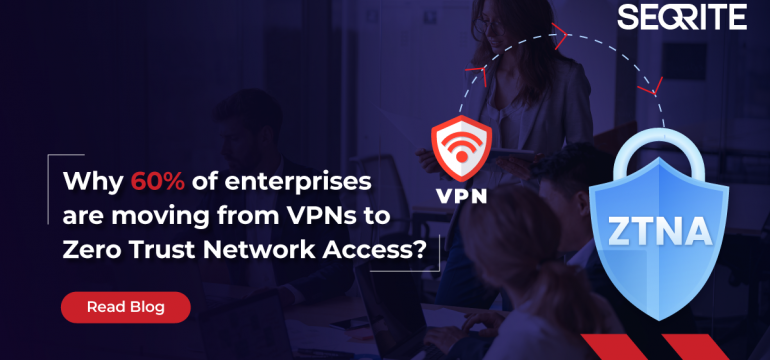Why 60% of enterprises are moving from VPNs to Zero Trust Network Access ?
In today’s rapidly evolving digital landscape, organizations are grappling with the challenges posed by remote and hybrid work models. As the traditional enterprise perimeter continues to erode, safeguarding sensitive data and critical applications has become a paramount concern for security leaders. Conventional security approaches, such as virtual private networks (VPNs) and network-centric firewalls, have proven inadequate in addressing the needs of the modern, borderless workforce. Recognizing the limitations of these traditional methods, a growing number of cybersecurity teams are turning to a new paradigm: Zero Trust Network Access (ZTNA). This innovative security solution has gained significant traction, with a recent survey by Gartner predicted a 60% adoption of zero trust network access over VPNs, highlighting the shortcomings of perimeter security. This transition prioritizes authentication, user context, and mitigates insider threats and unauthorized access by third parties, addressing the complexities of traditional VPNs.
The Growing Threat Landscape and the Limitations of Traditional Security v/s ZTNA
The rapid shift to remote and hybrid work models has fundamentally transformed the enterprise landscape, blurring the traditional network boundaries. Employees, contractors, and vendors now access critical applications and data from a variety of devices and locations, often outside the confines of the corporate network. This transition has introduced new vulnerabilities and expanded the attack surface, rendering conventional security measures increasingly ineffective.
VPNs, once the go-to solution for secure remote access, have proven to be inadequate in the face of these emerging challenges. They expose the entire network to potential threats, create performance bottlenecks, and require complex and costly maintenance. Moreover, VPNs often fail to provide granular control over user access, leaving organizations vulnerable to unauthorized access and lateral movement within the network.
Similarly, network-centric firewalls and perimeter-based security models struggle to keep pace with the decentralized nature of modern workplaces. These solutions are designed to protect the network as a whole, rather than focusing on the specific applications and resources that users need to access. As a result, they often grant excessive privileges, increasing the risk of data breaches and unauthorized access.
Introducing Zero Trust Network Access (ZTNA): A Paradigm Shift in Cybersecurity
In response to the shortcomings of traditional security approaches, Zero Trust Network Access (ZTNA) has emerged as a transformative solution. ZTNA is a security model that verifies the identity, context, and authorization of each user and device before granting access to applications and resources, regardless of their location or the network they are using.
Unlike VPNs and perimeter-based security, ZTNA creates a logical boundary around each application, rather than the entire network. This approach minimizes the attack surface and reduces the risk of lateral movement within the network. By continuously monitoring and verifying user and device behaviour, ZTNA can adapt access policies in real-time, ensuring that only authorized and trusted entities can interact with critical applications and data.
Key Features and Benefits of ZTNA
Enhanced Security
ZTNA’s core principle of “never trust, always verify” is a powerful deterrent against data breaches, malware infections, and unauthorized access. By implementing granular access controls and continuously monitoring user and device behavior, ZTNA minimizes the risk of compromised credentials and lateral movement within the network.
Improved User Experience
ZTNA delivers a seamless and efficient user experience, eliminating the need for cumbersome VPNs and providing fast, reliable access to cloud-based and on-premises applications. ZTNA supports bring-your-own-device (BYOD) scenarios and enables users to work from anywhere, on any device, without compromising security.
Simplified Management
ZTNA simplifies the administration and maintenance of remote access by providing a unified and centralized platform. IT teams can easily scale the remote workforce, manage access privileges, and enforce security policies without the complexity and cost associated with managing multiple security solutions.
Compliance and Regulatory Alignment
ZTNA’s emphasis on identity-based access controls and continuous monitoring aligns with the requirements of various industry regulations and standards, such as HIPAA, PCI-DSS, and GDPR. This helps organizations maintain compliance and reduce the risk of costly fines and reputational damage.
Cost Optimization
By eliminating the need for expensive VPN infrastructure and reducing the management overhead associated with traditional security solutions, ZTNA can deliver significant cost savings for organizations. Additionally, ZTNA’s ability to optimize network traffic and reduce bandwidth consumption can further contribute to cost efficiencies.
Read How to Build a Zero-trust Network (ZTNA)?
Seqrite ZTNA: A Comprehensive Zero Trust Solution
As organizations navigate the complexities of the modern digital landscape, Seqrite ZTNA emerges as a comprehensive Zero Trust solution that addresses the unique security challenges faced by enterprises.
Seqrite ZTNA is a SaaS-delivered Zero Trust Network Access solution that provides secure remote access to corporate applications and services for employees, contractors, and vendor staff across borderless workspaces. It offers a holistic Zero Trust approach, leveraging contextual policies, processes, and technology to authenticate every access attempt and grant the least-privileged application access to authorized users.
Key Features of Seqrite ZTNA
- Identity Management: Seqrite ZTNA seamlessly integrates with popular identity providers, such as Google Workspace and Microsoft Azure, as well as on-premises Active Directory servers. It also supports passwordless OTP-based authentication for local user management.
- Application Access: Seqrite ZTNA offers both agentless and agent-based access options, enabling secure connectivity to a wide range of protocols, including HTTP, HTTPS, RDP, SSH, Telnet, VNC, FTP, SMB, and more. It also provides seamless access to critical applications, such as Office 365 and Google Workspace, without exposing the network or application to the outside world.
- Zero Trust Policies: Seqrite ZTNA implements a default deny approach, allowing organizations to define granular policies that control which users have access to which applications, based on factors such as user attributes, device posture, location, and network details.
- Granular Application Controls: Seqrite ZTNA offers a range of advanced features, including the ability to restrict remote desktop sessions, control clipboard access and file transfer, monitor user activity through session recordings, and protect business-critical applications from layer 7 attacks using Web Application Firewall (WAF) rules.
- Simplified Management: Seqrite ZTNA’s visual-first administration console and intuitive policy management capabilities make it easy for IT teams to onboard users and applications, while also providing detailed insights into user access patterns and application usage.
Summing Up
As organizations embrace the benefits of remote and hybrid work, the adoption of ZTNA has become a critical component of modern cybersecurity strategies. By implementing a Zero Trust approach, enterprises can enhance their security posture, improve user experience, and streamline the management of their remote access infrastructure.
Seqrite ZTNA, with its comprehensive suite of features and seamless integration capabilities, can serve as a valuable partner in this transformation. By leveraging Seqrite ZTNA, organizations can establish a robust Zero Trust security framework, safeguard their critical assets, and empower their remote and hybrid workforce to work securely and productively.




